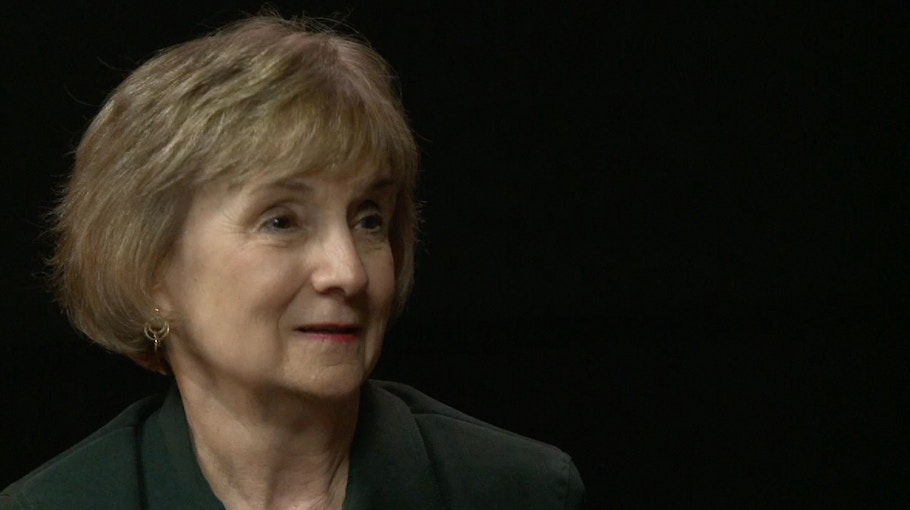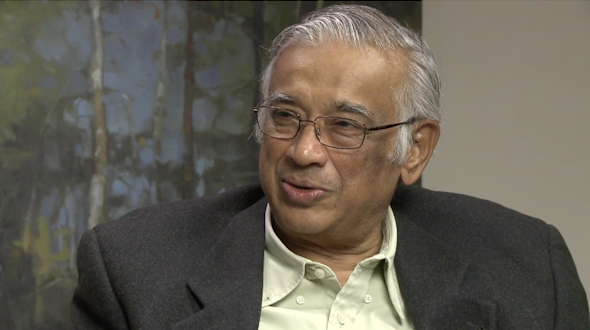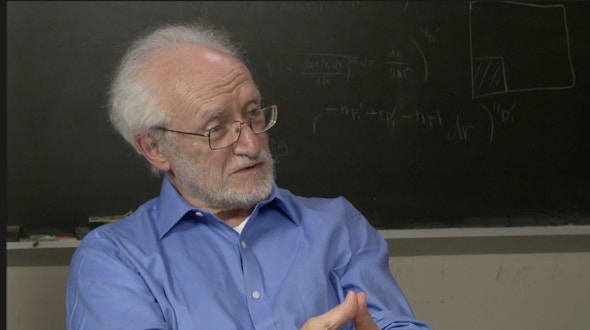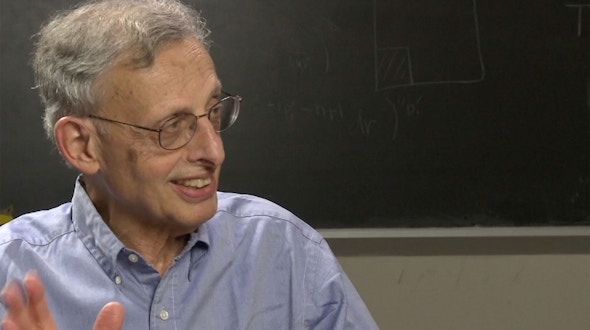Margaret Wright
- Highlights (3:54)
- Early Years in California, Arizona and Choosing Stanford (6:46)
- Faculty at Stanford in Mathematics and the New Computer Science (4:10)
- First Job at GTE Sylvania (5:31)
- Faculty in Math and Computer Science at Stanford (4:51)
- Work in England (3:24)
- Back to Stanford (2:48)
- Operations Research at Stanford (7:29)
- Is Linear Programming Polynomial Time (5:40)
- Karmarkars Algorithm (5:14)
- Creating Algorithms and Writing Software (11:25)
- Working at Bell Labs: a Liberating Experience (2:52)
- Bell Labs Nostalgia and Moving to Courant (6:04)
- Being Department Chair at the Courant Institute (4:26)
- Girls and Computer Science (3:30)
- Committees and SIAM (7:54)
- Advisory committees and the NAS (14:07)
- Editing SIAM journals (4:35)
- Applications That Work (4:07)
- Accomplishments and Progress for Women (5:44)
- Unexpected Connections (4:57)
Working at AT&T Bell Labs in the early 1990s, the very earliest days of Wi-Fi, one of Margaret Wright’s favorite projects was called WiSE — a “wireless system engineering” software package that solved the problem of how to optimize a building’s indoor base station antenna positions, factoring in the location and composition of 1,500 or more walls, floors and ceilings.
One might expect that Wright, a mathematician and computer scientist specializing in optimization, would have deployed similar strategies in plotting her career path, landing as she has at New York University’s storied Courant Institute. Wright, however, finds her professional trajectory anything but optimal.
The dictionary definition of the word “optimize” is to make the best or the most effective use of a situation, opportunity or resource. The technical meaning is roughly the same, said Wright, who coauthored two optimization textbooks and is currently working on a third with Philip Gill. “Finding the best, that’s what it means. It’s used all the time now in common parlance. When I started out, the term ‘optimize’ was hardly used at all except in scientific context.”
As for her career, she said modestly, it’s mostly been just random luck.
“I’ve been on a number of panels about women in math, women in computer science, and with every panel, the more senior women have said, ‘Well, I have a nontraditional career path’ and ‘I didn’t plan to do this’ and ‘When I started out I didn’t know what to do.’ And that’s really true of me. When I meet young women now — young people — I give them advice about if you want to do this, then it’s a good idea to do that, dat-da-dat-da-da. I didn’t have any of that, any of it. So nothing is optimal in my career. In fact, when you look at it, it’s sort of a miracle that I’ve ended up at the Courant Institute, really.”
•••
While Wright’s career path may not have been optimal in terms of finding “the best” or “the most efficient,” she has certainly optimized the various opportunities that presented themselves.
In the 1960s, studying for her bachelor’s degree in mathematics at Stanford University (also taking many classes in English, French and history) and then her master’s in computer science, Wright was sometimes the only woman in classes of 150 students. After a six-year stint as a scientific programmer at Sylvania (getting paid 30 to 40 percent less than male colleagues with lesser credentials), she returned to Stanford in 1971 as a doctoral student.

Supervised by Walter Murray, then at the National Physical Laboratory in the United Kingdom, she embarked on a thesis based on barrier methods for optimization problems with nonlinear constraints. “In the 1960s, a standard approach for dealing with constraints was to fold them into an unconstrained problem; barrier methods did this by adding an impassable barrier that forced constraints to be satisfied,” she said. “Despite earlier popularity, by the 1970s barrier methods were in decline, in large part because of concerns about provable ill-conditioning, meaning that a tiny change in the problem could lead to a huge change in the exact solution.” In Wright’s dissertation, she devised a new family of methods that avoided this ill-conditioning. However, her first post-thesis paper was rejected, without even being refereed. The journal’s editor characterized barrier functions as “both obsolete and badly behaved.” As a result she set aside barrier functions for a while, but her familiarity with them would later come in handy.
She received her doctorate in 1976. At that time 20 percent of her fellow doctoral students were women — a demographic split that is roughly the same today. “It’s shocking,” she said. “There are lots of theories about why this is the case, and the NSF has spent millions trying to find out. When I talk to people one-on-one — I talk to young women, and I’ll say, ‘Why aren’t you going into computer science?’ or ‘Why aren’t you pursuing computer science?’ And a lot of them say it’s the sociology of the field, that it’s not friendly to women. I was in a program committee meeting for a computer science conference and we were talking about getting well-known computer scientists to come, and we noticed that every one of them could be described as a quintessential nerdy male. And then someone — and a man — said: ‘You wonder why women don’t want to go in this field?’”
With her Ph.D. in hand, Wright was offered a soft-money position as research associate with the Stanford’s Systems Optimization Lab, run by George Dantzig, in the department of operations research. It wasn’t her dream job — it was non-faculty — but she took it. “People say to me now, ‘You should never have done that. That was a terrible move. It’s an inferior job. Why did you do it?’ Well, I did it.” A friend of Wright’s called it a “dead-end position.”
While at the lab, Wright worked closely with Philip Gill, Walter Murray and Michael Saunders, and their team —known as the “Gang of Four” — became involved in two tumultuous periods when linear programming made front-page headlines in The New York Times. Linear programming is an optimization problem — specifically the problem of minimizing a linear function subject to linear constraints. The simplex method, invented by Dantzig in 1947, dominated linear programming practice for more than 30 years because of its speed. As Wright explained, “Although almost always fast in practice, the simplex method can require an exponential number of iterations in the worst case. Hence there was widespread interest in finding a polynomial-time LP method that would be ‘faster’ than the simplex method in both theory and practice.”
A Barrier Method
In 1979, after many false alarms, the Soviet Union’s Leonid Khachiyan devised a polynomial-time “ellipsoid method” —The New York Times printed the news on A1 below the fold: “A Soviet Discovery Rocks World of Mathematics.” Researchers worldwide, including the Gang of Four, implemented Khachiyan’s method. Despite the hype about the huge improvement in theoretical complexity, numerical experiments showed that the ellipsoid method was almost always much slower than the simplex method.
Then, in 1984, Narendra Karmarkar of AT&T Bell Labs announced his invention of a polynomial-time algorithm. This news appeared front-page in The Times’ above the fold — “Breakthrough in Problem Solving” — with reports that "those who have tested the early versions at Bell Labs say that it already appears many times faster than the simplex method."
“There was an enormous level of excitement as well as mystery,” said Wright, “since AT&T declared that Karmarkar's work was proprietary. Dantzig invited Karmarkar to visit Stanford, and during his visit he wrote down equations that were strongly reminiscent of the equations that would arise if a barrier method were applied to linear programming — something that would never have been considered earlier, because of the total dominance of the simplex mindset.”
The Gang of Four and John Tomlin began to investigate and obtained two completely unexpected results. First, they showed that under certain conditions Karmarkar's method was formally equivalent to a barrier method. Second, they showed that for a wide variety of test problems a barrier method was competitive with the simplex method, and in some cases even faster. Wright presented these results at the 1985 International Symposium on Mathematical Programming at the Massachusetts Institute of Technology, and her talk was greeted with disbelief by many in the audience. “Several years of frenzied activity followed,” she recalled, “during which barrier functions and their generalizations became central rather than viewed as obsolete.”
In 1988, Wright started putting out feelers for new job opportunities, and along came the offer she happily accepted from AT&T Bell Labs, as well as one for a faculty position at the University of Wisconsin, Madison.
“It was paradise,” she said of Bell Labs. Working alongside legends like Ken Thompson and the late Dennis Ritchie (co-inventors of Unix), Brian Kernighan, Rob Pike and Bjarne Stroustrup, she could arrive at work at whatever hour and work on pretty much whatever she liked. “I would tell people about it and they’d say, ‘It doesn’t sound like you’re working very hard. It sounds like you’re just having a good time.’ And I’d say, ‘Well, I am having a good time, but I’m working very hard.’” She was a member of the technical staff in the computing science center, where her only obligation was to do good research, sometimes with practical applications, such as the cutting-edge Wi-Fi technology.
One accomplishment from the Bell Labs days of which she’s particularly proud is her contribution to a set of advances made for women’s status in the workplace. Wright’s tendency for activism had first come to the fore at Stanford. One faculty member called her the “Che Guevara of the computer science department” for her efforts to create a teaching evaluation process. At Bell Labs, her focus was on issues of women’s hiring, salaries and promotions. The prevailing mindset, anecdotally at least, was that “if women are unhappy here, they should find a place where they are happy, shouldn’t they?” A group of women disagreed. They circulated surveys and petitions and organized meetings with management. While some favored a more confrontational strategy, Wright and Julia Hirschberg, now chair of the computer science department at Columbia, took a moderate approach. They became the de facto leaders, although, as Hirschberg recalled, it was Wright who led the way. “Margaret’s a real leader,” she said. “You absolutely trust her — her judgment, fairness and humanity. With Margaret you feel there is no hidden agenda, no personal agenda. She is an extremely honest and effective person.” In addition to their affirmative action work, Wright and Hirschberg attended self-defense classes together as part of the empowerment process. Recalled Hirschberg: “One of our instructors said that Margaret was particularly ‘ruthless’ — he meant it as a compliment, of course! Margaret combines an amazing tactfulness with an uncompromising commitment to doing the right thing.”
Their efforts brought about increases in women’s salaries, as well as heightened awareness among male colleagues. Women were also added to the “promotable list,” and in short order two women were promoted to department heads — Hirschberg and Wright. That certainly wasn’t their motive, Wright noted. Nevertheless, she could hardly turn it down. Starting in 1997, she served as the head of the scientific computing research department for three years, earning praise for her management style. And in short order, in 2001 the Courant Institute tapped her to become chair of its computer science department, where she is now finally a “real professor,” a lifelong goal.
“She takes on the dirty jobs,” said Brian Kernighan, describing Wright’s management style. “Nobody likes to do them, but she did them, carefully, conscientiously. I saw this both at the Labs and then indirectly when she went off to NYU. She never let anything slide. She took responsibility for people who were not taking it for themselves. She is extremely good at that kind of thing, really unusually so.”
“Another thing that is intriguing from a personal standpoint,” Kernighan said, “is how she just knows everybody, and knows what’s going on with everything. She is totally on top of the whole technical field in computer science — not the technical work, per se, but the people involved. She is incredibly well connected. So if you want the latest gossip on somebody … ”
Wright’s talent for knowing everyone and everything comes as a result of the substantial amount of time she has invested — over and above her research and administrative roles, not to mention raising a family — in committee work and serving the computer science community.
“She’s been a dynamo,” said friend and colleague Dianne O’Leary, a computer scientist at the University of Maryland. “Her service to the profession has been extensive, with broad impact, and she is a wise mentor to many women, including me.”
Wright’s list of professional activities runs a full page on her CV. She has served as vice president and president of the Society for Industrial and Applied Mathematics (SIAM), and as editor in chief of the SIAM Review, among other journals. In 2010, she was chosen by the UK government’s Engineering and Physical Sciences Research Council (EPSRC) to chair a panel to assess the international standing of mathematical sciences research. Most recently, Wright served on a National Academy of Sciences study that in 2013 published its report, “The Mathematical Sciences in 2025” — reviewing the current and future status and strength of the discipline. One major emphasis was on education, Wright said, and “training young people to cope with big data — to cope with, as we say, ‘challenges’ facing the mathematical sciences.”
For all this, Wright’s scientific accomplishments have been recognized with many honors. She was elected a member of the National Academy of Sciences in 2005, to the American Academy of Arts and Sciences in 2001, and to the National Academy of Engineering in 1997. She has received awards for public service from SIAM and from the American Mathematical Society.
And in 2000, the Association for Women in Mathematics invited her to deliver the prestigious Emmy Noether Lecture, honoring “women who have made fundamental and sustained contributions to the mathematical sciences.” She spoke on the mathematics of optimization, emphasizing her current research on direct search derivative-free methods. As is often her wont, she peppered her talk with quotations from literary contexts. She likes to borrow from Marcel Proust, Oscar Wilde, Sir Arthur Conan Doyle and even the Bible. For this occasion, she rummaged through the searchable online text of Jane Austen’s works and found a few apropos quotations, such as, “He had something to direct his search,” from Pride and Prejudice, and, from Mansfield Park, “There will be little rubs and disappointments everywhere, and we are all apt to expect too much; but then, if one scheme of happiness fails, human nature turns to another; if the first calculation is wrong, we make a second better.”
And then there is another bit of Austen, from Emma, that one might apply to Wright’s non-optimized career path: “You make the best of it.” And then some.



